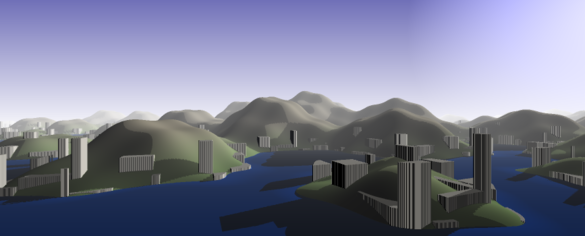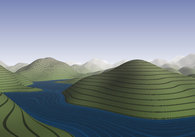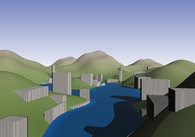Tracing a terrain
Published on 7 March 2009
This is a basic terrain rendering filter for Pixel Bender based on the Quasi-Analytic Error-Bound (QAEB, or "kweeb") ray tracing algorithm.
QAEB tracing is a raymarching algorithm for rendering realistic looking terrains using procedural fractal functions first introduced by Ken Musgrave. After reading the chapter about it in the excellent book, "Texturing & Modeling: A Procedural Approach", I thought it might make an interesting challenge for an interactive Pixel Bender filter.
The process is fairly unsubtle; a ray vector for each pixel is fired into the scene and its offset, y, above a 2D height field, f(x, z), is calculated. The ray is repeatedly stepped, or marched, forward until it intersects the terrain. At this point the colour for the pixel is determined based on its calculated height and angle between the surface normal-vector and sun position. A secondary ray can be fired off from the intersection point towards the sun and if it intersects the terrain again we know that the original surface point must be in shadow.
A couple of optimisations can be used to speed up the rendering. Firstly the step interval can be increased proportionally with distance as the geometric details get smaller in screen space the deeper into the scene. The second optimisation requires the scene to be rendered from the bottom up (near to far). It uses the calculated scene depth of the pixel below the one we want to calculate as the starting point for its ray as we know that as we move up the image we go deeper into the scene. However, Pixel Bender calculates many pixels in parallel on the GPU and so you can't use the result of one pixel calculation as the starting point for another, which unfortunately means we can't take advantage of this second optimisation.
This filter uses a composition of sinusoidal functions at different frequencies to generate the height map. It's by no means perfect but at a low altitude gives a reasonable cartoon-like landscape where the repeating structure isn't obvious. I created a different version that used Perlin noise for the height field, which generated a much more realistic terrain but would cripple Pixel Bender causing a few hard reboots! I'm porting this version to Processing and will post about that soon.
Other features such as the water level are set by clipping the height field at a lower limit and building like structures can be generated using a combination of modulo functions. There is also an option to overlay contour lines on the terrain.
For more technical details on terrain rendering and other excellent computer graphics goodies see Inigo Quilez's site.
Download the Landscape PixelBender filter
See the Adobe PixelBender page for instructions on using the filters with Photoshop CS4 and After Effects

Last updated: 7 March 2009
11 Comments
Older: Escher's Droste Effect Newer: Fractals and generative art talk
Links & further reading
- Download the landscape Pixel Bender filter
- Texturing & Modeling: A Procedural Approach
The definitive book on the subject.
- Inigo Quilez
Many insightful computer graphics articles by this demo-scene master.

Contours

Sea level rising

Waterfront
Related posts
- Introducing Frax
- The project I've been working on for the last two years...
- L'Eclaireur
- A series of looping animations from an installation at L'Eclaireur in Paris.
- Fractal Lab
- A WebGL fractal explorer
- Little Planets
- A Pixel Bender plugin for Photoshop, After Effects and Flash to create stereographic projections, or 'Little Planets'
- More blog posts
it´s really a mess the pb-contest wasn´t opened for non-americans...
I know, but I submitted this filter to the contest anyway ;-)
Kudos, as always this is very impressive!
Runs fine on my computer - though it took my some time to realize that you had to turn off Flash Player warnings in order to run the filter :-)
Cheers Syntopia. There is a define statement at the start of the filter that should tell Pixel Bender to disable Flash warnings, but the current version seems to just ignore it.
Very interesting read as usual Tom. On a side note, I love that your example graphics always come out so polished.
Look forward to the processing version!
Jaw dropping!
I love the buildings, especially.
Just super neato.
Does Pixel Bender support 3d transformations? Or Did you simulate the camera? I will look through the filter right now, but couldn't stop asking you!
Satya, Pixel Bender supports matrix operations which you can use to do 3D transformations. I used this when rotating the camera and positioning the sun.
That's cool. But can the matrix be integrated into AE camera by default?
Ahh no, you can't integrate the AE camera. The Pixel Bender filters will only apply a bitmap effect on a standard 2D layer in AE.
As always, this is very impressive work, it runs fine of my computer =)